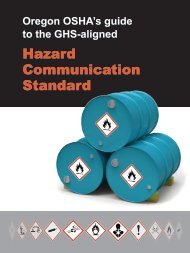Technical Manual - Section 3 (Safety Hazards)
Technical Manual - Section 3 (Safety Hazards)
Technical Manual - Section 3 (Safety Hazards)
Create successful ePaper yourself
Turn your PDF publications into a flip-book with our unique Google optimized e-Paper software.
Enabling Device<br />
A manually operated device that permits motion when<br />
continuously activated. Releasing the device stops robot<br />
motion and motion of associated equipment that may present<br />
a hazard.<br />
End-effector<br />
An accessory device or tool specifically designed for<br />
attachment to the robot wrist or tool mounting plate to enable<br />
the robot to perform its intended task. (Examples may<br />
include gripper, spot-weld gun, arc-weld gun, spray- paint<br />
gun, or any other application tools.)<br />
Energy Source<br />
Any electrical, mechanical, hydraulic, pneumatic, chemical,<br />
thermal, or other source.<br />
Envelope (Space), Maximum<br />
The volume of space encompassing the maximum designed<br />
movements of all robot parts including the end-effector,<br />
workpiece, and attachments.<br />
Restricted Envelope (Space)<br />
That portion of the maximum envelope to which a robot is<br />
restricted by limiting devices. The maximum distance that<br />
the robot can travel after the limiting device is actuated<br />
defines the boundaries of the restricted envelope (space) of<br />
the robot.<br />
NOTE: The safeguarding interlocking logic and robot<br />
program may redefine the restricted envelope (space) as the<br />
robot performs its application program.<br />
(See Appendix D of the ANSI/RIA R15.06-1992<br />
Specification).<br />
Operating Envelope (Space)<br />
That portion of the restricted envelope (space) that is actually<br />
used by the robot while performing its programmed motions.<br />
Hazardous Motion<br />
Any motion that is likely to cause personal physical harm.<br />
Industrial Equipment<br />
Physical apparatus used to perform industrial tasks, such as<br />
welders, conveyors, machine tools, fork trucks, turn tables,<br />
positioning tables, or robots.<br />
Industrial Robot<br />
A reprogrammable, multifunctional manipulator designed to<br />
move material, parts, tools, or specialized devices through<br />
variable programmed motions for the performance of a<br />
variety of tasks.<br />
Industrial Robot System<br />
A system that includes industrial robots, the end-effectors,<br />
and the devices and sensors required for the robots to be<br />
taught or programmed, or for the robots to perform the<br />
intended automatic operations, as well as the communication<br />
interfaces required for interlocking, sequencing, or<br />
monitoring the robots.<br />
Interlock<br />
An arrangement whereby the operation of one control or<br />
mechanism brings about or prevents the operation of another.<br />
Joint Motion<br />
A method for coordinating the movement of the joints such<br />
that all joints arrive at the desired location simultaneously.<br />
Limiting Device<br />
A device that restricts the maximum envelope (space) by<br />
stopping or causing to stop all robot motion and is<br />
independent of the control program and the application<br />
programs.<br />
Maintenance<br />
The act of keeping the robots and robot systems in their<br />
proper operating condition.<br />
Hazard<br />
A situation that is likely to cause physical harm.<br />
III:4-15
















